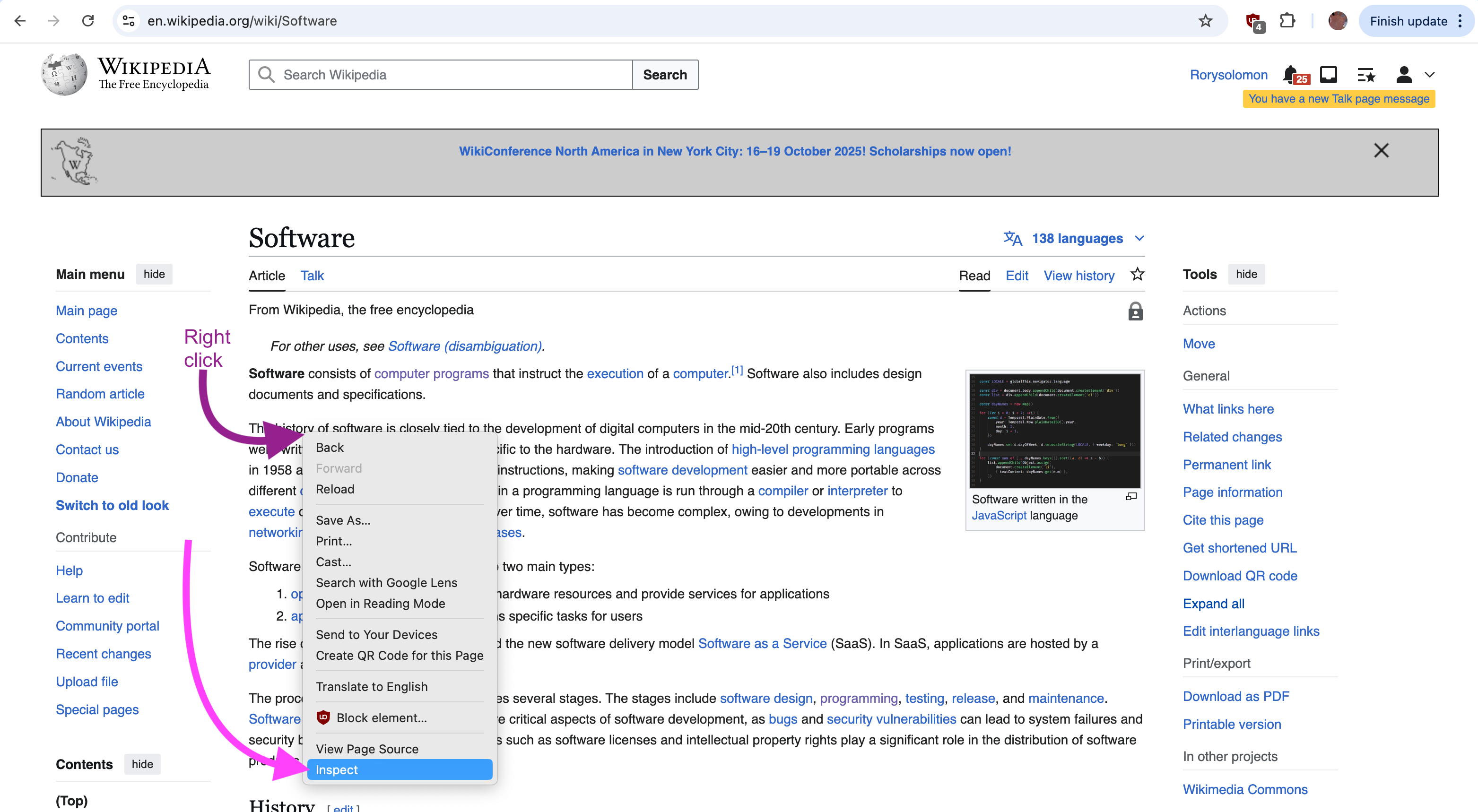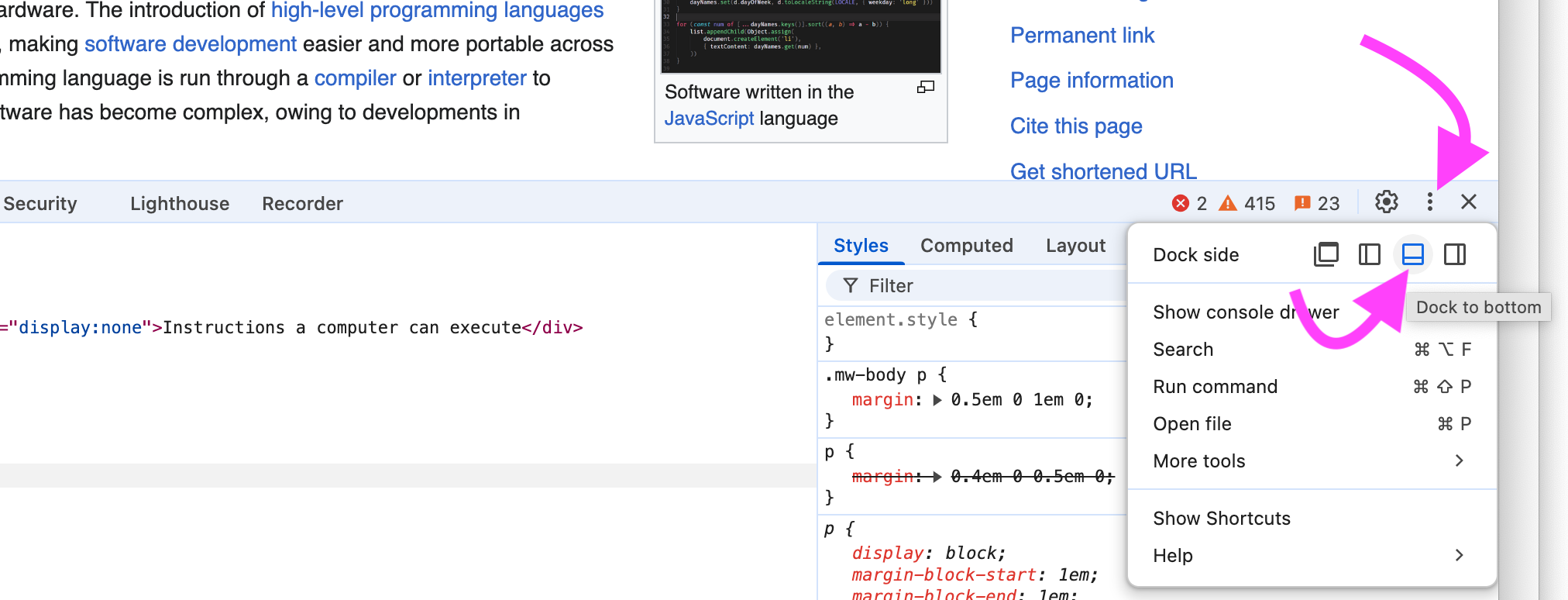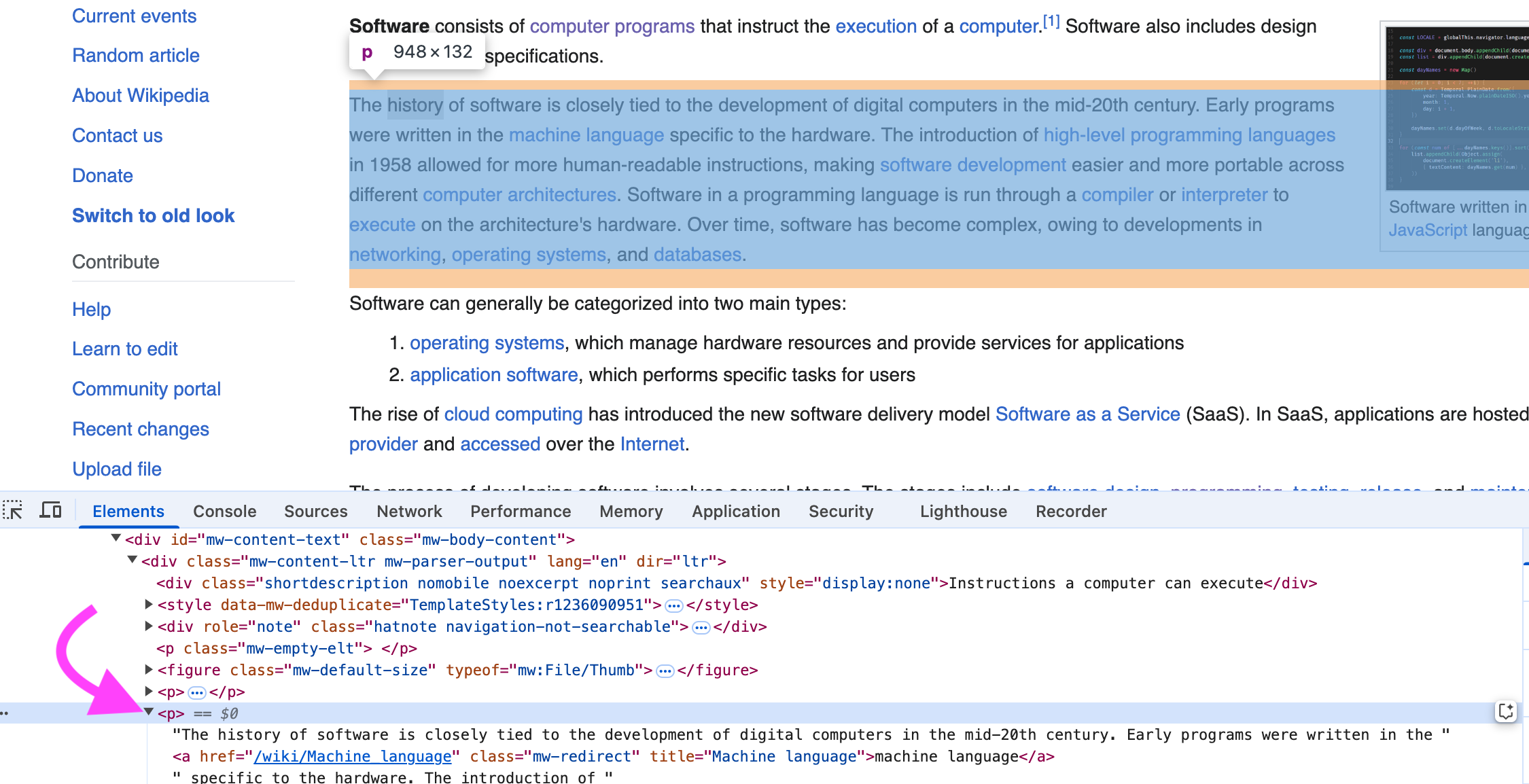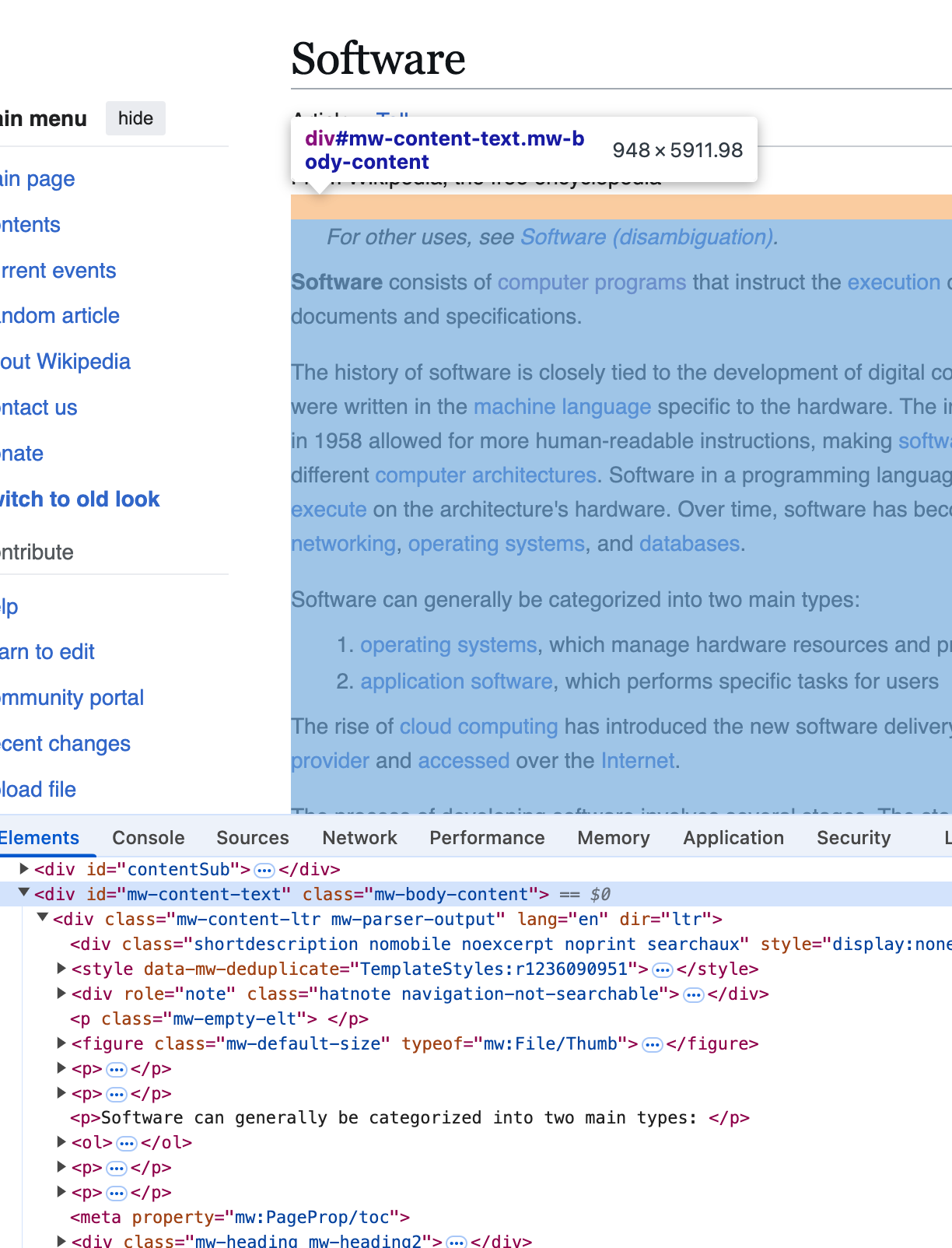Code as a Liberal Art, Spring 2025
Unit 2, Lesson 2(b) — Tuesday, April 1
More on parsing with Beautiful Soup
Table of contents
- Anatomy of an HTML tag
- Examining an example: scraping a Wikipedia page
- Implementing our example: scraping a Wikipedia page
- A web crawiling example: the Wikipedia Philosophy game
- Wrapping up & homework
I. Anatomy of an HTML tag
HTML tags are defined by brackets which must
always come in pairs of open <
and close >.
The text between the brackets is said to be inside the brackets, and is what defines the tag.
Some common tags:
<div>, <h1>, <h2>, <h3>
(and <h4>
etc), <p>, <img/> <a>.
Most tags come in pairs, called the open
and close tag, which is indicated with a
forward slash /. For example: <p>
</p>. The text between the tags is said to
be inside the tag, and it is affected by
whatever properties the tag indicates.
Some tags like <img> end with a trailing
slash / before the last bracket and do not come
with a corresponding close tag because they
simply include an object on the page and do not have any
text inside them.
Tags can contain other tags, nested recursively like a classic Russian Matryoshka doll metaphor. This is another example of the modularity that we discussed when talking about the Manovich text.
Additional text can be included inside the brackets of the
opening tag, and are called attributes. These
are defined as key-value pairs indicated with
an equal sign = and they define additional
properties of the tag. For example:
<p id="42" class="user-profile" >
The most common attributes are id
and class.
The id attribute uniquely
identifies one tag on the page.
The class attribute is used to
define a group of tags on the page.
In web scraping, we use tag names, IDs, and classes to select certain tags (also known as elements) on the page from which we want to extract and save content. This process of selecting certain tags is also called targetting.
(jump back up to table of contents)II. Examining an example: a Wikipedia page
Let's look at an example. A Wikipedia page.
As a goal, let's try to request this page, download the response, and save the textual content.
Remember from Unit 2 Lesson 2 that we could simply make a
Beautiful Soup object and call get_text() on it, but
that would give all the human-visible text on the page,
including various menus, headers, footers, references, and other
things we wouldn't want if we plan to use this text as the
corpus for generating other human language.
So, our modified goal will be to request a page, downnload the response, and extract all the main text on the page, not including the various menus, etc.
We'll do this by first accessing the page manually, viewing the source, and trying to identify the tags, classes, and IDs that define where that main content of the page is.
Let's look at this URL:
https://en.wikipedia.org/wiki/Software
Right-click somehwere in the area of text that we're interested in. In this case, a main body paragraph. Click inspect to open the Developer Tools window (a.k.a. DevTools).
You can arrange your DevTools workspace however you'd like. I like putting the DevTools at the bottom of the browser window. I would advise you to do the same as I think it is most readable. But it's up to you. You can adjust the position of this window here:
You can mouseover various tags in the Elements tab of DevTools and it will highlight that section of content on the page. You can also click the litlte arrows to expand/contract the content of each tag to see its contents.
From looking through the HTML elements of this page, it looks
like what we are interested in is the content of all
the <p> tags that are contained within
the <div> that has
attribute id="mw-content-text" .
OK, now our task is getting clearer. We need to parse this HTML
to access the textual content of only these tags —
i.e. all <p> tags
contained inside <div
id="mw-content-text">
... </div>.
This is precisely what Beautiful Soup is for.
(jump back up to table of contents)III. Implementing our example: a Wikipedia page
Let's make a new folder for this
work: Unit 2 Lesson 2b. And make a new
Python file in this folder. I'll call
mine parse.py.
Let's build on what we talked about in Unit 2 Lesson 2.
Add the two import statements at the top.
Request the page using the requests objects
and get(). Then make a BeautifulSoup
objects with the response.
import requests
from bs4 import BeautifulSoup
response = requests.get("https://en.wikipedia.org/wiki/Software" )
soup = BeautifulSoup(response.text, "html.parser")
The rest of this lesson will make extensive use of the Beautiful Soup documentation. I will be sharing certain commands from this library and explaining what they do. I advise you to refer back to this documentation as the definitive source for all Beautiful Soup commands, with full and precise explanations of what they do.
find_all():
the real powerhouse of Beautiful Soup.
It returns a list. Try printing a random paragraph.
import requests
from bs4 import BeautifulSoup
response = requests.get("https://en.wikipedia.org/wiki/Software" )
soup = BeautifulSoup(response.text, "html.parser")
all_paragraphs = soup.find_all("p")
print( all_paragraphs[4] )
OK, but we only want some paragraphs — i.e. the
ones inside the <div> with
that id.
Let's use find_all() to target that <div>:
import requests
from bs4 import BeautifulSoup
response = requests.get("https://en.wikipedia.org/wiki/Software" )
soup = BeautifulSoup(response.text, "html.parser")
all_paragraphs = soup.find_all("p")
print( all_paragraphs[4] )
main_div = soup.find_all(id="mw-content-text")
print( len(main_div) )
I don't want to print out
that entire <div>, so let's
just print the length of the list that find_all
returns.
As we might expect, the length is one! Why? Highlight: [Because id always indicates one unique item on the page.]
The find_all() command has an argument that could
be useful here: limit=X
soup.find_all(id="mw-content-text",limit=1)
But there is an even better way of doing this. When you know
that find_all() will only return one item, you can
use find(),
which searches for an element and always returns one
(or None if no matching elements found):
import requests
from bs4 import BeautifulSoup
response = requests.get("https://en.wikipedia.org/wiki/Software" )
soup = BeautifulSoup(response.text, "html.parser")
main_div = soup.find(id="mw-content-text")
print( len(main_div) )
Remember:
— find_all()
will always return a list of items, even if that list only
contains one item, or none.
— find() will always
return one item, but if none are found, that will be the
special Python null object None.
Now that we have the main div that we are looking for,
let's get all the <p> tags within that:
import requests from bs4 import BeautifulSoup response = requests.get(url) soup = BeautifulSoup(response.text, "html.parser") main_div = soup.find(id="mw-content-text")print( len(main_div) )main_p_tags = main_div.find_all("p")
And now that we have all the <p> tags,
let's make a new empty string variable, loop over
the <p> tags, get the text of each one, and
append that to the string:
import requests
from bs4 import BeautifulSoup
response = requests.get(url)
soup = BeautifulSoup(response.text, "html.parser")
main_div = soup.find(id="mw-content-text")
main_p_tags = main_div.find_all("p")
main_text = ""
for p in main_p_tags:
main_text = main_text + p.get_text()
Now, main_text will contain all the text that we're
interested in from this article.
Finally, to fulfill the task
of exercise 3, let's add a
list of URLs, loop over that, and put all the above code into
that loop so it repeats once for each URL in the list. I will
also add a text file, and each time through the loop we will
write the variable main_text to that file.
import requests from bs4 import BeautifulSoup urls = [ "https://en.wikipedia.org/wiki/Software", "https://en.wikipedia.org/wiki/Compiler", "https://en.wikipedia.org/wiki/Database", "https://en.wikipedia.org/wiki/Operating_system", "https://en.wikipedia.org/wiki/Computer_network", "https://en.wikipedia.org/wiki/virus" ] wikipedia_file = open('wikipedia.txt', 'w') for url in urls: response = requests.get(url) soup = BeautifulSoup(response.text, "html.parser") main_div = soup.find(id="mw-content-text") main_p_tags = main_div.find_all("p") main_text = "" for p in main_p_tags: main_text = main_text + p.get_text() wikipedia_file.write(main_text)
Running this should produce one text file
(wikipedia.txt) that will contain the text of all
the articles we've added to our URL list. You can expand
this corpus by manually adding new URLs to the
list.
We will use a corpus like this as the basis for the next part of the project which is to generate human language sentences using a Markov model.
(jump back up to table of contents)IV. A web crawiling example: the Wikipedia Philosophy game
Finally, let's turn our attention to exercise 2: adding a queue to do web crawling.
Note the brief discussion about queues from Unit 2 Lesson 2, section II.d.
A queue is typically implemented with a list, which begs the question: what then exactly is a data structure? A data structure is a technical object with certain specific usage patterns.
A queue in this case then is a list that is being used as a queue — by adding stuff at the end, and removing stuff from the beginning. The so-called FIFO behavior (first in, first out).
What are some alternatives to FIFO? In class we talked about LILO (last in, last out) — but, it turns out that LILO is actually the same behavior as FIFO.
The most common alternative to the FIFO model is LIFO (last in, first out). This behavior is used with a list to implement a data structure known as a stack. Stuff is both added and removed from the same "end" of the list.
By analogy, if queues are used to manage people showing up to get some kind of resource ("customers will be served in the order they arrive"), then a stack could be used for something like an organization that had to lay people off and seeking to do so fairly by recognizing seniority, letting go of newer people first.
In digital systems, stacks are used in many ways. How programming language parsers keep track of recursively nested syntax like parenthesis or HTML tags, and how the programming language keeps track of subroutines that call other subroutines.
We won't be using a stack for this exercise as the queue is the more appropriate data structure for web crawling.
The key operations of a queue:
-
pop(0): returns (and removes) the first item in a list. (We have not seen this command yet.) -
append(): adds an item to the end of a list. (We have already seen this command!)
The goal with the Wikipedia Philosophy game is to find the first link in the first main paragraph of the Wikipedia article that is not a link about word pronunciation.
After some difficulty in class with some subtleties of parsing this out in the HTML code of Wikipedia pages, I arrived at the following example:
import requests
from bs4 import BeautifulSoup
import urllib.parse
queue = [ "https://en.wikipedia.org/wiki/Software" ]
while len(queue) > 0:
url = queue.pop(0)
print("url: ", url)
if "/Philosoph" in url:
print("Done!")
exit()
response = requests.get(url)
soup = BeautifulSoup(response.text, "html.parser")
main_div = soup.find(id="mw-content-text")
main_div_p_tags = main_div.find_all("p")
# Some nuanced parsing here to handle different cases.
# Wikipedia page HTML code is pretty uniform, but there
# still are some variations and exceptions:
first_p = None
i = 0
while not first_p:
maybe_first_p = main_div_p_tags[i]
if "class" in maybe_first_p.attrs and "mw-empty-elt" in maybe_first_p.attrs["class"]:
i = i + 1
continue
if len(repr(maybe_first_p)) < 20:
i = i + 1
continue
first_p = maybe_first_p
first_a = first_p.find_all("a",limit=1)[0]
href = first_a.attrs["href"]
new_url = urllib.parse.urljoin(url,href)
queue.append(new_url)
One issue I had in class was a typo in how we access the URL
from an <a> tag. I was accidentally
trying a.href — oops! wrong — the
proper syntax is the line above that looks like this:
href = first_a.attrs["href"]
Modify the initial value of queue to include
whatever URL you wish to start with, then run this, and you
should see it print out all URLs on its way ultimately to
"Philosophy" (or something that starts with
"Philosoph" — I had some issues with other
similar terms creating loops and thought it was sufficient just
to end for example on "Philosophy_of_language").
a. Is this really a queue?
But is this really a queue? It is an example of a list being used as a queue, but it's not the most interesting example because in this particular crawling case, we only ever have at most one item in the queue at a time!
A more interesting example would be if, on each page we visit, we found multiple URLs, and added them to the queue. In that case, the queue would be getting longer as we processed each page. This would be a way to build a corpus of all articles that are linked to some starting article. This would be a great way to automate the process of building a very large corpus, selecting links automatically by following a web of relations, rather than having to select a bunch of URLs manually (in a list, like we did above).
To modify the above example to do this, you could adjust the
code that looks for only the first <a> tag
only in that first <p>, and instead look for
all <a> tags within
all main_div_p_tags for
example. Then append() each URL to the queue, and
save the text to a file as before.
You would probably also want to add some stopping condition here. Otherwise your crawler would just keep going on forever! You could add a new variable, set it to zero, and each time you request a page, increment that variable. Then stop when you have accessed enough pages, whatever enough is for you.
I will leave this as an exercise for you to try, and I hope some of you do try this for the generation of your corpus for the project.
(jump back up to table of contents)V. Wrapping up & homework
Using the techniques here you should now hopefully be able to complete the tasks laid out in Unit 2 Lesson 2 homework.



